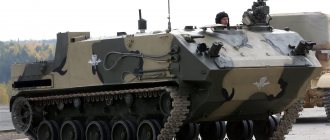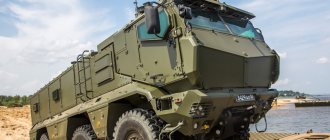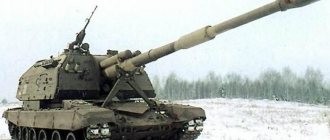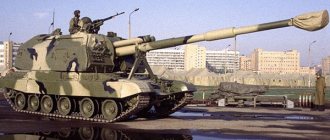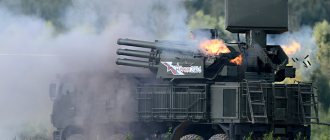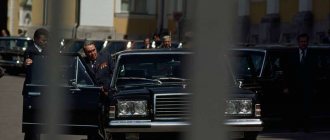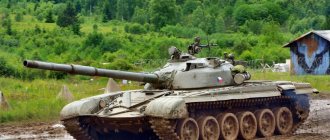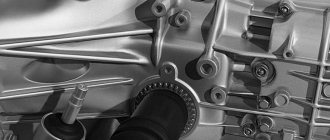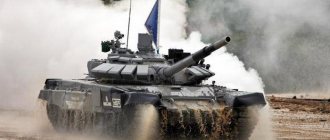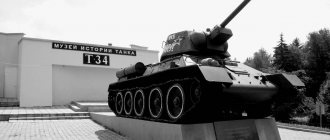A little history
The reason for the creation of the T-72 was the protracted introduction of the T-64, the new main tank of the Soviet Army. The vehicle was equipped with an original 5TDF diesel engine with counter-piston movement, for the assembly of which a special production facility was launched in Kharkov. However, the plant's potential ensured the production of vehicles only in peacetime; any increase in vehicle production led to a shortage of power plants.
As an alternative, a version of the tank with a simpler B-45 diesel engine, which was mastered by industry, began to be considered. The tank was supposed to be produced at a plant in Nizhny Tagil.
The first developments of the Morozov Design Bureau to equip T-64 tanks with the B-45 diesel engine date back to 1961. As a result, by 1967, three vehicles were built under the designation “object 436”, which underwent a series of intensive tests. After that, the engine and transmission were installed on the modernized T-64A tank.
This is how “object 438” was born, which was tested in 1967-68. Based on the Order of the Minister of Defense Industry, a batch of “Object 439” vehicles was assembled, which were slightly different from their predecessors. Tests have shown that the characteristics of vehicles with V-45 and 5TDF diesel engines are identical.
But for a number of reasons, “object 439” did not go into production in Nizhny Tagil.
One of the reasons is competition between tank builders from different design bureaus. In the Urals they decided to create a new vehicle based on the components of their own “object 167”, supplemented by an automatic loader. But some of the solutions for the hull and turret were borrowed from the T-64, although the parts were not interchangeable. The resulting vehicle received the designation “object 172M”, which became the T-72, which received the prefix “Ural”.
In 1973, Uralvagonzavod assembled the first production batch of 30 tanks, and full production began the following year. The launch of the T-72 series became possible thanks to Marshal Grechko, who actively lobbied for the interests of Uralvagonzavod. The parallel production of T-64A and T-72, vehicles of the same level and purpose, which had an extremely low degree of unification, is nonsense for Soviet military equipment.
Modifications and experimental versions
Several dozen experimental and serial modifications have been created based on the T-72 vehicle. Immediately after the start of serial production, projects appeared to re-equip the tank with another weapon. In the first half of the 70s, a single tank “Object 172MN” was created, which was distinguished by the installation of a rifled 130-mm gun model 2A50. At the same time, experiments were carried out on the installation of a 125 mm 2A49 smoothbore gun. These cars were not included in the series.
An interesting experiment was the “object 186”, equipped with a 16-cylinder diesel engine with an X-shaped cylinder arrangement. The engine developed power up to 1200 hp, but turned out to be extremely unreliable.
For commanders of tank formations, a command version of the vehicle designated T-72K, equipped with a set of navigation equipment and radio stations, was intended. To operate from the site, the station used an additional antenna 10 m high, which provided communication at a distance of 300 km. The installation of energy-intensive equipment has led to a reduction in the number of stowages and the transportable ammunition load is 31 rounds.
In 1979, the T-72A tank went into production, differing from its predecessor in improved sighting devices, a modernized gun, a smoke grenade launcher, a modified diesel engine and other components. On the basis of the modernized version, the T-72AK command vehicle was built with ammunition reduced to 36 rounds. To operate the expanded electronic complex, an autonomous generator set driven by a small engine is used.
The T-72M version was offered for export, differing in its turret protection scheme and ammunition load. A little later, in 1982, it was replaced by the T-72M1, equipped with an additional 16 mm thick sheet mounted on the front of the hull. The combined turret armor also received sand-filled internal rods.
Since 1985, T-72AV tanks with mounted dynamic protection containers began to arrive on the domestic market, and a little later the production of T-72B began. The vehicle is distinguished by a modernized cannon adapted to launch anti-tank guided missiles, as well as an 840-horsepower V-84-1 diesel engine. Due to changes in the defense scheme, the shape of the tower became more rounded. The command version of the vehicle became known as the T-72BK.
In the early 90s, tanks began to be equipped with built-in dynamic protection, borrowed from the T-80U.
The new version received the designation T-72B model 1989, there is an unofficial designation - T-72BM. The export version of the T-72B began to be designated as T-72S (or T-72M1M).
Subsequently, modernization programs were developed to the T-72B2 standard, and then B3. The main emphasis in the improvement is on the use of modern electronic and sighting equipment, as well as the installation of active protection systems.
In addition to battle tanks, a number of auxiliary and engineering vehicles were built on the T-72 base. Among them are the BREM-1 evacuation tractor and the MTU-72 bridge-laying machine. The T-72 chassis served as the basis for the MSTA-S self-propelled gun.
T-72B3_1
It's simple: ice gets on the armor after overcoming the anti-tank ditch.
It's simple: ice gets on the armor after overcoming the anti-tank ditch.
It's simple: ice gets on the armor after overcoming the anti-tank ditch
Without a jerk, the colossus weighing forty-six tons (!) starts moving. And then, at the moment when I should be bursting with pride, I understand: in that very rush I forgot to look where the levers were! That is, he knew that there was no rudder or steering wheel in the tank, and therefore was not embarrassed by the emptiness in the place where they could be. But not finding the levers ahead of time is a shame. Fortunately, the T-72B3 crawls straight, and I try to correct the mistake. Yes, here they are - right at hand. I literally clench the controls in my fists and finally calm down. Okay, second gear. I switched with a slight jerk, but it will do for the first time - I’m not used to the clutch yet. The third one is already better. I press the gas harder, and the tank obediently accelerates. Although communicating with the seven-speed shift mechanism does not cause problems, I probably don’t need to go faster - I’ll get a better feel for how the tank is controlled.
Easily
Here it is, modern technology, it turns out that physical strength is not needed to communicate with levers. Pull the left one towards you - the tank deviates to the left, pull the right one - to the right. Almost effortless. What is needed is not strong, but precise movements. The response to control actions follows without delay - the tank immediately begins to perform the maneuver. The way of controlling the steering wheel, which is crammed into the subcortex of the brain, does not interfere at all, and every minute I like the levers more and more. It’s a pity there was no room for the snake between the cones to pass during the short test drive. I'd love to try it. But I still depicted two 180-degree turns. After riding the T-72B3 just a little, you quickly understand how long you need to hold the lever when turning and when it’s time to release it. And, most importantly, like a passenger car, a tank does not like sudden movements. It is also desirable to operate the controls smoothly.
Design
The hull of the T-72 tank is made by welding from rolled and cut to size armor steel sheets. The upper frontal plate of the hull has a combined protection scheme. The thickness of the sheet is 200 mm, which corresponds to 550-600 mm of conventional armor (located at the same angle to the normal). The sheet includes outer and inner steel layers, between which fiberglass laminate is placed. The bottom sheet is made of ordinary armor steel with a thickness of 85 mm.
The T-72's side armor is mounted vertically and has a thickness of 80 mm in the area of the habitable compartments and 70 mm in the area of the engine and transmission compartment. The internal part of the armor in the habitable compartments has a coating that protects against damage by neutron radiation. A bulldozer blade is installed under the lower frontal plate, allowing you to dig a protective trench for installing the tank. Depending on the hardness of the soil, excavation work takes 20...25 minutes.
For additional protection, four flat shields made of a light alloy based on aluminum are installed on the sides of the T-72 vehicle.
Before the start of hostilities, the flaps are moved forward to an angle of 60⁰, protecting the tank’s side armor from damage by cumulative ammunition. This design was later abandoned in favor of a solid screen made of fabric-reinforced rubber.
Starting with the version of the T-72AV tank, which went into production in 1985, additional dynamic protection from separate containers began to be installed on the frontal part of the hull and turret. An additional 20 mm sheet of armor was also mounted, placed on the upper main sheet of the hull.
The T-72 tank uses a cast turret with variable wall thickness. The armor protection is of the usual type, the frontal part has a thickness of up to 280 mm. Later, with the start of production of the T-72A version, combined armor with the installation of sand cores began to be used. The use of such armor improved resistance to shell hits. At the same time, the shape of the front part of the tower changed, where protrusions (“cheekbones”) appeared.
The crew of the T-72 tank consists of three people. The driver's workplace is located in the center of the hull in the bow. Above the mechanic there is a separate hatch made in the top plate of the hull. The seat is lowered almost to the floor, which ensures a sitting position for the mechanic.
On many foreign models, the driver is placed in a reclining combat position, which negatively affects the comfort of work.
Three internal fuel tanks are located on the sides of the driver's workplace. The tank is controlled by two levers and pedals.
The T-72 turret houses seats for two tank crew members, with the gunner located on the left side and the commander on the right. On the roof of the tower there is a rotating commander's cupola, equipped with a pair of observation devices. Outside of a combat situation, the commander sits on the vehicle's turret, covered with a removable shield. To ensure communication there is a VHF radio station. There is a narrow passage between the tower and the control compartment.
Theoretically, a person can walk there, but in fact this requires some training. Experience in the combat use of the T-72 tank showed that it was impossible to pull the wounded driver out through this passage. Evacuation is carried out through the standard hatch in the roof.
The power compartment with a transversely mounted engine is located in the rear part of the vehicle hull. The power unit on the T-72 tanks is a 780-horsepower V-shaped 12-cylinder four-stroke diesel engine V-46-6, equipped with a centrifugal air blower driven by the crankshaft. The motor has forced liquid cooling. Structurally, the diesel engine is a development of the V-2 tank engine, tested on the T-34 and BT-7.
During subsequent modernizations, the B92S2 diesel engine, built on the same cylinder block, but equipped with a turbocharger, began to be used. The power of the power plant increased to 1000 hp. The engine compartment of T-72 tanks allows you to seal joints and overcome water obstacles up to 5 m deep along the bottom. Additional equipment is pre-installed on the machine.
Various types of diesel fuel, aviation kerosene, low-octane gasoline grade A-72, as well as mixtures of these types of fuel can be used as fuel.
Inside the T-72 tank there are fuel tanks that can hold 705 liters of fuel. Four barrels with a capacity of 200 or 275 liters can be mounted outside.
The car engine is started using an electric starter, which acts as a generator when the engine is running. When the starter operates, a voltage of 48V is used; in other circuits, a voltage of 22-29V is considered the norm. Four batteries are used to power the starter.
The transmission of the T-72 tank includes a guitar that transmits torque to two onboard gearboxes. On the output shafts of the machine boxes, final drives are installed, transmitting rotation to the drive wheels. The tank guitar is a single-speed step-up gearbox equipped with places for installing a compressor, a generator and a radiator fan for the cooling system.
T-72 onboard gearboxes are built on the basis of planetary gearboxes and provide seven forward speeds and one reverse speed. The gear shift control is hydraulic; the box includes an onboard clutch. The use of spaced boxes allows you to control the rotation of the tank by engaging a lower gear in the lagging track. Due to this, there are seven different turning radii of the machine.
An additional final drive is also built according to a planetary design and serves to reduce the speed of rotation of the drive wheel. Despite the identity of the transmission circuit, the components of the T-64 and T-72 tanks are not interchangeable.
The chassis of the T-72 tank is equipped with individual torsion bars, complemented by bladed hydraulic shock absorbers on the first two front and last rear rollers. The torsion bar is located across the tank along the entire width of the hull. The machine's torsion bars are equipped with balancers with double-disc support rollers, which have external shock absorption in the form of a rubber band.
To limit the travel of the T-72 suspension, there are bumpers into which the balancers rest.
The rollers have a paired design and are made of aluminum alloy. Each side of the vehicle has six road wheels. The drive wheels are located at the rear and are equipped with replaceable ring gears. The front uses cast idler wheels equipped with a crank to provide track tension. The lantern track track is made up of 97 links with a width of 580 mm.
There is a track option with an open hinge or with a rubber-metal unit (RMH). Due to the different design of the tracks, the ring gears of the drive wheels are different. The upper branch of the caterpillar rests on three rollers equipped with an internal shock absorber.
The main armament of the T-72 tank is the 125 mm D-81TM cannon (later the 2A46 model began to be used), equipped with a barrel with a smooth internal channel. The gun has a built-in two-axis electro-hydraulic stabilizer, allowing targeted fire while moving. The vehicle's ammunition load (44 rounds, 39 on early models) includes various shells, as well as missiles. The T-72B modification uses the upgraded 2A46M-5 gun, which uses more effective ammunition.
The electromechanical automatic loader installed on the tank allows firing at a frequency of up to 8 rounds per minute. The shells and charges are arranged separately in two tiers on a horizontal tray, the loading angle is constant.
The cartridge case has a design that partially burns when fired - only the bottom remains, which is thrown out. By ejecting the remains of the cartridge case, it was possible to reduce the gas contamination of the internal volume of the T-72 tank during firing. 22 projectiles and charges are placed on the automatic loader trays. The rest of the vehicle's ammunition is placed in stowage units mounted in the turret and hull. As the shells are spent, the crew places the ammunition in the machine's trays.
When switching to manual loading, the firing rate is reduced to 2 rounds per minute. A stabilized sight with a built-in rangefinder (early machines used a conventional optical one) allows firing in the daytime at a distance of 4000...5000 m. The firing range at night is up to 2000 m.
An infrared spotlight is used to illuminate targets at night.
On early T-72 vehicles it was installed on the front of the turret to the left of the gun, but then it was moved to a point located above the embrasure of the coaxial machine gun. The modernization was carried out to improve the safety of the driver, since there were cases of fatal injuries caused by the spotlight. When using additional sighting equipment, the T-72 cannon allows firing high-explosive fragmentation shells at a distance of 9...10 km.
A 7.62 mm belt-fed PKT machine gun is installed in the same installation with the cannon. One belt includes 250 rounds. A total of eight tapes are stored in the T-72 tank. The machine gun allows you to fire at a distance of up to 1800 m (using a rangefinder sight). To protect against air attacks, there is a 12.7 mm Utes machine gun mounted in a special installation on the commander's cupola. The installation has a sight that allows firing at ground targets.
The machine gun is belt-fed; one belt contains 60 rounds. The transportable ammunition includes five belts. Inside the tank there is one AKMS assault rifle of 5.45 mm caliber, as well as a signal 26 mm pistol-rocket launcher. For close defense there are 10 F-1 fragmentation grenades. To clear roads from mines, a trawl model KMT-5 or 6 is used.
T-72B3
Where does the ice on the armor come from?
Where does the ice on the armor come from?
“Where does the ice on the armor come from?” - you ask.
The diesel engine makes a quiet noise at idle. Why am I making such a fuss getting into the driver’s seat? No one is urging me on, but I still rush like I’m on fire. Oh, captain, it’s not a good time when you said that the engine at idle speed consumes more than twenty liters of diesel fuel per hour. For an ordinary motorist - a shock. When you think about such an expense, you involuntarily begin to “drive the horses.”
Finding a common language
He stuck the body into the hatch. It's cramped here, but tolerable for thin people. I look around. Here is the “comb” of the gear shift mechanism and the lever, here is the clutch pedal, here is the gas. Brake? I see! The pedal is pressed almost to the floor using an impressive lever - yeah, that's how the handbrake is implemented here. It seems that everything is ready to go. I'll try. Not fluff, of course, but I expected much greater effort from the controls. The left foot easily presses the clutch pedal, the right foot holds the brake removed from the handbrake without much strain. I engage first gear without any problems - it’s impossible to miss here. Foot from the brake to the gas. I add speed and gently “pull” the clutch pedal - it wasn’t enough to stall in front of everyone. Happened!

